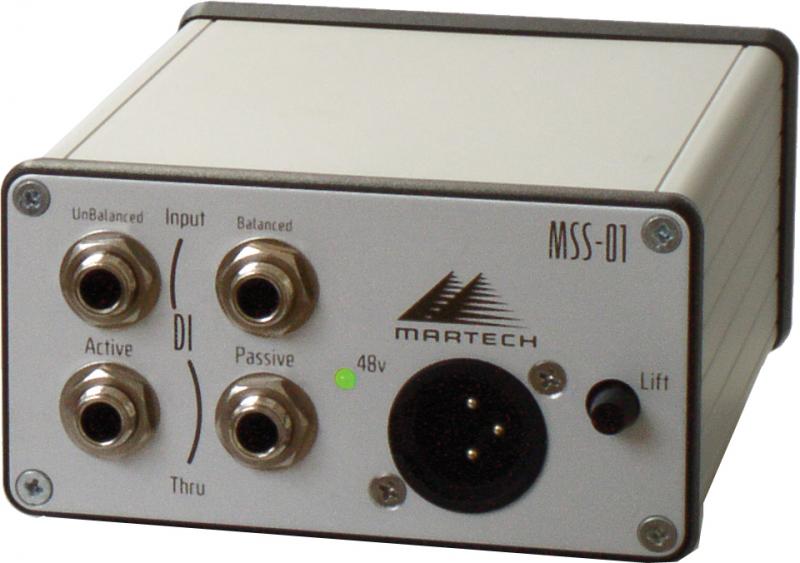The Martinsound Martech MSS-01 is a pristine quality, high-fidelity direct input box with a passive and active circuit
The Natural Instrument Interface
As the Martech MSS-10 Micro-phone Preamplifier became popular with discerning users, requests increased for a direct box that would give them that same "high fidelity with soul" they love about their MSS-10s.
Staying true to the design of the MSS-10, the MSS-01 starts by using the same custom transformer to provide a sonically superior passive path that accommodates both balanced and unbalanced sources, and then adds a German microphone quality active input to lighten the load when required for vintage guitars.
Join the hit makers who have already discovered magic in the Martech Modular Studio Series. Experience the artistic satisfaction from using an MSS-01 and turn your dreams into legend.
Another Direct Box
At Martinsound we build and offer exclusively to our studio clients, a passive direct box based on the design of our renowned Martech MSS-10 Microphone Preamplifier. Musicians, engineers, and producers who try it agree that our direct box sounds bigger, clearer and more open than the high-end boxes they bring to the sessions. With no surprise, demand grew for a commercial version.
A transformer is used in a passive direct box to match the high impedance output of an instrument to the low impedance input of a mic preamp. By lowering the impedance of the signal, it is less susceptible to interference and can drive longer distances without reacting to cable capacitance, thus preventing high frequency loss. The transformer also reflects a proportionally higher input impedance from the mic preamp, lessening the load on the instrument.
The Martech MT-1005 input transformer has a 10:1 ratio, dividing the output impedance of the instrument by 100 while multiplying the mic preamp input impedance by 100. Mic preamps have an input impedance ranging from 1.5k to 10k ohms, which, when reflected across the transformer, will range from 150k to 1M ohms. Some vintage guitar pickups can sound dull and lifeless when driving less than 500k ohms, rendering the MT-1005 unsuitable for these instruments if the mic preamp input is below 5k ohms. Adding a FET to the front end would fix the input impedance at a high value, but at what cost to the transparent sound of the transformer
The best of both worlds was our design decision: the ultimate passive direct box, and the finest sounding high impedance active direct box. Adding an active path meant addressing issues such as power supply, headroom, and sonic degradation, and our decisions are what sets the Martech MSS-01 apart from the pack.
Phantom power was an obvious choice for this design. We added large power reserve capacitors for maximum headroom, and optimized supply rails providing 40 volts peak to peak for clean operation. The circuit is similar to that found in high-end condenser microphones, rather than a standard FET direct box, with a little Martech design magic to minimize the characteristic 'tzzzz' of the FET. Martech went over the top once again to minimize components in the signal path, basing the design on how it sounds, not just test equipment measurements.
The MSS-01 is a unique choice in a vast universe of direct boxes. It provides a phenomenally transparent interface that allows instruments to bloom and sound the way they're supposed to: natural.
Why Use the MSS-01
The unique instrument interface provides a sonically superior passive path that accommodates both balanced and unbalanced sources, and a German microphone quality active input to lighten the load on vintage guitars.
How Does It Sound
Actually the question should be, "How does your instrument sound" For that is what the MSS-01 will reveal. The soul intent of the MSS-01 is to let you hear every nuance from your instrument, without adding any coloration.
Why Not Always Use the Active Input
This is a subjective issue that only you can decide. Many purists want a minimal signal path, so they go straight for the Passive Input. It is recommended that you listen to the instrument on both inputs instead of assuming which will sound better. The unique circuit for the Active Input requires a 15 minute 'warm up' period, much like tube equipment. It is important that you apply phantom power and wait for the circuit to settle before comparing the two inputs. Listen to the Passive Input during warm up for a reference and then switch to the Active Input. Listen for excessive dullness or fly away in the top end, keeping in mind that brighter is not always better. Also listen for depth and imaging before determining the best loading for the instrument.
Why a Balanced Input On a Direct Box
When a typical guitar cable is used the tip/sleeve plug will automatically unfloat the input of the transformer, making it like most other DIs, but the MSS-01 can handle the rare occasion when an instrument has a balanced output. And clever engineers will figure out all sorts of uses for the 10:1 transformer.
What is Natural Sound
If something sounds "better" than its source, the coloration is called euphonic, whereas if it sounds worse, we have many esoteric or vulgar words to describe it. But when it sounds the same, the only word to describe it is natural. Natural is not sterile or neutral. Sterile means unable to produce or lacking vitality. If anything, natural sound is the antithesis of sterility. And natural isn't just accuracy, for it moves one into the realm of realism.
Natural Sound is breathtaking, an aural seduction. Unconstrained dynamics that never get pinched at high levels. A highly focused image with low level ambience and room information that doesn't mysteriously disappear. Brilliant tonal quality with lots of air. It's top end that isn't smeared, midrange with warmth, and extra octaves of an extended bottom that is fat and solid. And when punch is required, stand back. Natural sound is all this and more because nothing is removed.
